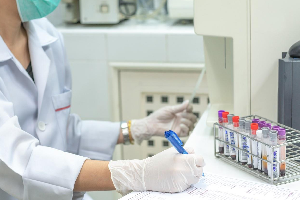How Does RHD Genotyping Affect Your Practice Financially?
Download Kacker et al. (2015) Study

Though Rh blood typing is routinely performed for expectant patients, there are times when the results may not be clear. In a 2-6% of women, test results may be ambiguous: one test may indicate RhD negative while another may show RhD positive, or the typing may be weaker than expected, indicating the patient may be a Rh genetic variant.
These discrepancies or uncertain typing reactions can complicate treatment, as it is unclear whether the patient should be treated as RhD positive with no prophylaxis for Rh disease required, or RhD negative, where Rh immune globulin (RhIG) is needed to avoid hemolytic disease of the fetus/newborn (HDFN).
Currently, many facilities utilize a conservative strategy—OB-GYNs treat uncertain results as RhD negative to prevent possible HDFN; however, this approach may result in excessive use of resources and unnecessary exposure to RhIG, which is a human blood product. RHD genotyping provides a cost-effective solution.
What Is RHD Genotyping?
There are a few factors that can contribute to differing RhD typing results;
- Variation in testing methods between laboratories
- Variation in result interpretations
- Variation in reagent antibody clone specificity and reagent formulation
- Variation in RhD antigen expression on red blood cells (RBCs)
The last factor may result in a serologic weak D phenotype. Individuals with weak D status are usually first identified serologically as individuals whose RBCs show no reactivity or weak reactivity in testing. Though the current practice is often to treat patients with a weak D type as RhD negative, individuals with certain RHD variant genes can be safely considered RhD positive.
RHD genotyping identifies the particular gene variant associated with the patient’s weak D type. Patients identified as weak D Types 1, 2 or 3 can safely be treated as RhD positive, and thus don’t require RhIG. On the other hand, individuals with gene variants other than weak D Types 1, 2 or 3 may be at risk of hemolytic disease and are candidates for RhIG prophylaxis. In this way, RHD genotyping helps healthcare professionals make informed decisions regarding RhIG administration.
Financial Implications of RHD Genotyping
Sandler et al. (2015) report that, of the estimated 3,812,000 pregnancies occurring in the United States every year, approximately 556,500 of those occur in RhD negative women. However, approximately 16,700 of those individuals aren’t truly RhD negative, but instead have a weak D type. Furthermore, given the prevalence of different RHD gene variants, it is estimated that around 13,360 of those 16,700 pregnancies are in women with weak D Types 1, 2 or 3, who are safe to treat as RhD positive.
Since RhD negative women are typically given both antepartum and postpartum injections of RhIG, this means that approximately 24,700 doses are administered to women who should be considered RhD positive, and therefore, don’t need RhIG. RHD genotyping identifies this group of patients, thereby reducing unnecessary RhIG administration.
Kacker et al. (2015) analyzed the financial implications across the entire healthcare system associated with RHD genotyping of pregnant women with serologic weak D types compared to the conservative strategy of treating women with serologic weak D types as RhD negative. Their model took into account the additional testing cost of RHD genotyping, the cost savings associated with reducing unnecessary RhIG administration to women with weak D Types 1, 2 or 3, and the prevalence of alleles encoding weak D Types 1, 2 and 3 among individuals of different ethnicities.
In general, they found that implementation of RHD genotyping for women with serologic weak D types would be essentially cost neutral across the entire population; however, over time it could result in modest cost savings due to RHD genotyping being a one-time expense, while savings associated with reduced RhIG administration continue over subsequent pregnancies. In addition, women with weak D Types 1, 2 or 3 could certainly experience individual cost savings over time, along with avoiding unnecessary exposure to a human blood product.
How Often is RHD Genotyping Performed?
RHD genotyping is a one-time test—ideally during the woman’s first pregnancy. Repeating RHD genotyping during subsequent pregnancies is unnecessary if results are made part of the patient medical record. While RHD genotyping may be relatively new in the field of obstetrics, the information it provides will reduce excess use of RhIG and guide appropriate management of patients through future pregnancies.
For more on the cost of RHD genotyping, download Kacker et al. (2015) here.
